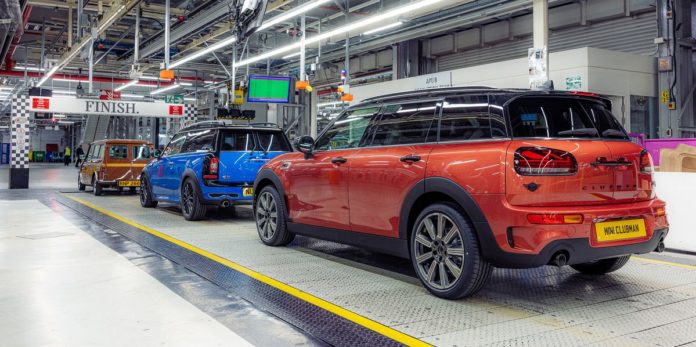- Mini Clubman production goes idle, marking the end of the line for a nameplate originally introduced in 1969, with 1.1 million units having been produced over 55 years, albeit with a 25-year hiatus.
- The automaker released the Final Edition of the Clubman last year, producing 1969 units that featured a number of unique details.
- Mini plans a batch of new electric models with the four-door Aceman EV, a crossover that is due to enter production this year and is seen as a replacement for the Clubman.
Mini has ended production of the Clubman at its Oxford plant in the U.K. this week, as planned, with the last example rolling off the assembly line in a ceremony attended by plant workers as well as the original Clubman model.
The nameplate itself debuted all the way back in 1969. In all, over 1.1 million units have been produced over 55 years, with half of them coming from the automaker’s Oxford plant in the U.K.
The model itself was developed as one of two station wagon variants of the basic Mini model, produced under several brands by British Motor Corporation (BMC). One was the Morris Mini Traveller and the other was the Austin Seven Countryman, with the latter nameplate being revived decades later for Mini’s SUV offering.
Yet another version was dubbed the Mini Clubman, arriving on the scene in 1969, by which time BMC had quite a variety of the basic Mini two-door models including under the Wolseley and Riley marques.
Penned by Roy Haynes, the Clubman went on to spawn two related models, including the Clubman Saloon, with the model staying in production with various updates until 1982.
Almost 600,000 units of the original Clubman were built, though the basic Mini itself remained in production for over a decade longer, until the year 2000.
The Clubman returned in 2007 with BMW’s acquisition and relaunch of the Mini brand, retaining the signature split rear doors. But even engineering the doors themselves was not an easy task with modern safety requirements.
“We needed to ensure that both doors would always open fully without obscuring the rear lights, which was a legal requirement,” said Guy Elliott, Lead Quality Engineer, who worked on the development team at the time. “Achieving this required fine tuning and developing the gas strut system to ensure the doors functioned correctly in all climatic conditions.”
The third generation of the Clubman arrived in 2015, with the model growing in size as a new four-door Mini Cooper hardtop model joined the range as well.
But the Clubman remained distinct from the taller four-door Countryman model that also joined the lineup around this time, with the former serving as the flagship of the Mini range positioned above the four-door Coopers.
Mini produced The Final Edition of the Clubman in 2023, featuring a number of unique details including a Shimmer Copper radiator grille and 18-inch two-tone alloy wheels, in addition to other touches. Just 1969 examples of this Final Edition model were built, in tribute to its launch year.
But at the end of the day, we suspect that one of the reasons for its departure was the fact that the current model was not different enough from the four-door Cooper hardtop, while also being quite a bit more expensive. Its closest competitor, therefore, was the new four-door Cooper model that arrived with the 2014 generation.
Does the end of Clubman production spell the end for the nameplate and the basic layout for the Mini brand?
Mini’s electric plans certainly contemplate a number of models with new bodystyles. The automaker launched the electric Cooper and Countryman months ago and will launch a new Aceman model later this year.
The Aceman itself was previewed in concept form back in 2022 alongside the wonderful Urbanaut concept released a year earlier, featuring some of the styling cues we’ve now seen on the new Countryman model including the revised headlight shape.
The four-door Aceman will sit between the Cooper and the Countryman, occupying about the same spot as the Clubman once did. But it won’t have split opening doors, instead featuring a more familiar hatch as well as more of a bustleback profile.
This model will likely replace the Clubman’s spot in Mini’s lineup, expected to offer a range of around 250 miles and a choice of single- and dual-motor layouts. The Aceman is expected to be revealed in production form this spring.
But it won’t have a gas-engine variant, unlike the new Cooper and Countryman.
Mini won’t be done filling out its lineup with the debut of the Aceman. The brand is also expected to introduce “a new crossover model in the small-car segment,” a little later, perhaps in 2025 or 2026, that could be a small MPV previewed by the Urbanaut concept of 2021. Firm details for this future model aren’t available just yet, but Mini has quite enough on its plate this year.
“We are incredibly proud to have built the Mini Clubman at Plants Oxford and Swindon over the last 18 years for customers all over the world,” said Markus Grüneisl, CEO of Plants Oxford and Swindon.

Jay Ramey grew up around very strange European cars, and instead of seeking out something reliable and comfortable for his own personal use he has been drawn to the more adventurous side of the dependability spectrum. Despite being followed around by French cars for the past decade, he has somehow been able to avoid Citroën ownership, judging them too commonplace, and is currently looking at cars from the former Czechoslovakia. Jay has been with Autoweek since 2013.


